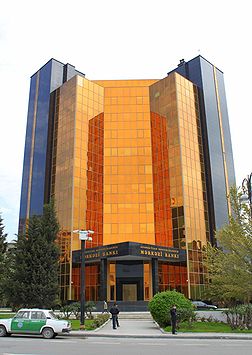- Central Bank of Azerbaijan
-
Central Bank of Azerbaijan
Azərbaycan Mərkəzi BankıCentral Bank of Azerbaijan Headquarters Baku, Azerbaijan Coordinates 40°22′43.18″N 49°50′43.39″E / 40.3786611°N 49.8453861°E Established 1992 Governor Elman Rustamov Central bank of Azerbaijan Currency Azerbaijani manat ISO 4217 Code AZN Base borrowing rate 5.25% Website http://www.cbar.az The Central Bank of Azerbaijan (CBA, Azerbaijani: Azərbaycan Mərkəzi Bankı) is the central bank of Azerbaijan Republic. The headquarters of the bank are located in the capital city Baku.
Contents
Mission and ownership
CBA is Azerbaijan's monetary authority, and is responsible for the conducting the country's monetary policy and regulation of the banking and payment system. Primary objective of CBA as stated in the Act on CBA is price stability. Secondary objective is to support a banking and payment stability.[1]
The CBA is owned by the Republic of Azerbaijan and managed by the Executive Board of the CBA. The Board is responsible for the supervising the administration and activities of the bank and for other statutory tasks. The bank is governed under the Act on the CBA, passed in 2004.
The bank has regional branch offices in Nakhichevan, Ganja, Yevlakh, Khachmaz, Goychay and Bilasuvar
Executive Board
The Executive Board is composed of the Governor, who is the chairman of the Board, and 4 members appointed in double process by President and the National Assembly.
Governor - Elman Rustamov
Board Members - Alim Guliyev, Aftandil Babayev, Vadim Khubanov and Khagani Abdullayev[2]
History
In early 1992, former Soviet banks were incorporated into the National Bank of Azerbaijan; The 1992 Law on Banks and Banking Activity and the Law on the National Bank established the CBA as the top level of the new system and commercial banks (state and private) on the second level. However, in 1993 the system was undermined by poor technology, large unresolved debts among state- enterprises, irregular participation by enterprises, and bank delays in transferring funds. The main bank for the exchange of funds among private and state enterprises is the Industrial Investment Joint Stock Commercial Bank.
According to results of the plebiscite in 19 Mar 2009 the Bank has renamed as Central Bank of Azerbaijan
Monetary policy
A limitation on FDI in the banking sector was reduced when the CBA increased the limit on participation of banks with foreign ownership from 30 to 50 percent of the commercial banking market. In June 2002, the NBA liberalized some overseas transfer provisions for Azerbaijani legal residents, including an increase of advance payments for import transactions from $10,000 to $25,000 and waiver of all restrictions for withdrawing foreign currency in cash.
During the world economic crises in 2008-2009 monetary policy orientation of Central Bank of Azerbaijan has strictly expanded: refinancing rate was cut down from 15% up to 2%, reserve requirement ratio form 12% up to 0.5% [3]. In exchange rate policy CBA maintained financial stability holding a pegged regime against the US dollar [4].
In postcrisis period some elements of economic overheating started to appear and Central Bank of Azerbaijan reacted with policy tightening since Autumn of 2010. So, refinancing rate was gradually enhanced up to 5.25 percent.
See also
- Economy of Azerbaijan
- Azerbaijan manat
- Banking in Azerbaijan
- List of banks in Azerbaijan
References
- ^ Act on the Central Bank of Azerbaijan Republic (in Azerbaijan language)
- ^ http://en.trend.az/capital/banks/1655137.html Parliament approves candidates for Azerbaijani Central Bank's board members
- ^ Chronology of main policy rate of Central Bank of Azerbaijan
- ^ Chairman of the National Bank of Azerbaijan: Manat devaluation is not expected
External links
- (Azerbaijani) (English) Central Bank of Azerbaijan
Categories:- Central banks
- Baku
- Banks established in 1992
- Banks of Azerbaijan
- Azerbaijan stubs
- Bank stubs
Wikimedia Foundation. 2010.

